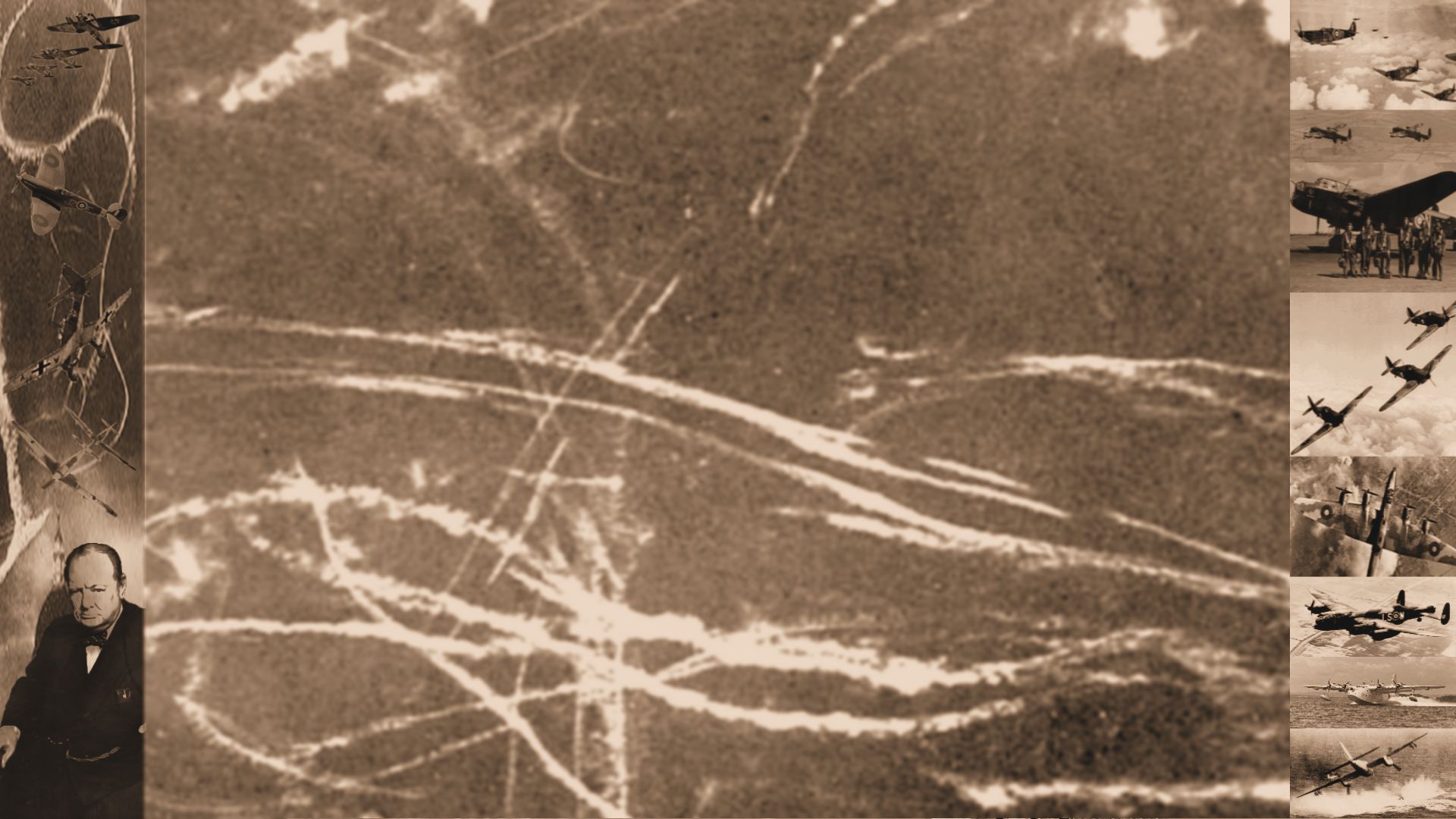 Hawker 'Tempest' Hawker 'Tempest'
The Hawker Tempest was a British fighter aircraft primarily used by the Royal Air Force (RAF) in the Second World War. The Tempest was an improved derivative of the Hawker Typhoon, intended to address problems with the Typhoon's unexpected low performance by replacing its wing with a much thinner laminar flow design. It emerged as one of the most powerful fighters used during the war. Back to Top
Development
In March of 1940, Hawker initiated a number of design studies aimed at improving the new Typhoon. Sir Sydney Camm, Hawker Aircraft's Chief Designer was already hard at work trying to improve the Typhoon and among these studies were ways of improving the Typhoon's high altitude performance. These involved the use of a new wing design that featured a thinner wing section and a reduced wing area. In order to save development time, Camm decided to mate the new wing to a modified Typhoon airframe which retained the Sabre engine powerplant. Camm and the Hawker design team placed a high priority on making their aircraft easily accessible to both air and ground crews; to this end the forward fuselage and cockpit areas of the earlier Hurricane and the Tempest and Typhoon families were covered by large removable panels providing access to as many components as possible, including flight controls and engine accessories. Both upper wing roots incorporated panels of non-slip coating. For the pilot a retractable foot stirrup under the starboard root trailing edge was linked to a pair of handholds which were covered by spring-loaded flaps. Through a system of linkages, when the canopy was open the stirrup was lowered and the flaps opened, providing easy access to the cockpit. As the canopy was closed the stirrup was raised into the fuselage and the flaps snapped shut. The RAF ordered two prototypes under Specification F.10/41 18 November of 1941 and the project quickly became known as the Typhoon II. The Air Ministry had already ordered 400 Tempests in August but production of the new Sabre IV engine ran into protracted problems and delays. Hawker went into production with the Sabre II engined 'Tempest V', with the first rolling off the production line on 21 June 1943. The first 100 Tempest Vs were fitted with 20 mm (.79 in) Hispano Mk.IIs with long barrels which projected ahead of the wing leading edges and were covered by short fairings; later production Tempest Vs switched to the short-barrelled Hispano Mk.Vs, with muzzles flush with the leading edges.
Back to Top
Tempest II
The decision to drop the Hawker 'Tornado' allowed Camm and his design team to transfer the alternative engine proposals for the 'Tornado' to the more advanced Typhoon II (later to be renamed 'Tempest'). Apart from the new engine and cowling, the Tempest II prototypes were similar to early series Tempest Vs. The Centaurus engines were closely cowled and the exhaust stacks were grouped behind and on either side of the engine: behind these were air outlets with automatic sliding "gills". The carburettor air intakes were in the inner leading edges of both wings, with an oil cooler and air intake in the inner, starboard wing. Orders had been placed as early as September 1942 for 500 Tempest Mk.IIs to be built by Gloster but in 1943, because of priority being given to the Typhoon, a production contract of 330 Tempest Mk.IIs was allocated instead to Bristol, while Hawker were to build 1,800. This switch delayed production even more. The first Tempest II was rolled off the line on 4 October 1944 and the first six production aircraft joined the two prototypes for extensive trials and tests. Tempest Mk.IIs produced during the war were intended for combat against Japan, and would have formed part of a proposed British Commonwealth long range bomber force based on Okinawa, called 'Tiger Force'. However, the Pacific War ended before they could be deployed.
Piloted by Philip Lucas, the first prototype Tempest was flown on September 2, 1942, but prior to this in February 1942, a production order had been placed and the first production machine flew in June 1943 with Bill Humble at the controls. During flight trials the first Tempest prototype had exceeded 477 mph in level flight and the first production model was essentially similar to the first prototype with the chin-type radiator.
Back to Top
In Service
The first squadrons to be equipped with Tempest Vs were Nos. 3 and 486 at Newchurch, Dungeness, the first of these receiving its equipment early in 1944. In June, modified propellers were fitted which solved the problem of five Tempest Vs that had been lost due to engine failure which was discovered to be due to an over speeding of the propellers and two days after the invasion of the Continent on June 8, 1944, the Tempests met enemy aircraft in combat for the first time, destroying three Bf 109G fighters without loss. On June 13, the first V1 flying bombs were launched against England, and the Tempest, being the fastest low-medium altitude fighter in service with the RAF, became the mainstay of Britain's fighter defense against them destroying 638 V1's by the beginning of September. The Tempest V was also employed on the Continent for train-busting and ground-attack duties. Due to the commitment by RAF Squadrons No. No. 3 and No. 486 in intercepting V1's, they did not participate in the battles over Normandy, leaving it to the Typhoons to support ground assaults and the breakout after the Battle of the Falaise Gap. Tempests forming 150th Air Wing were used in long range patrols(Rangers) where they would perform both long range patrols deep into Germany, destroying trains, strafing airfileds and general interdiction where possible. Along with drop tanks, they were equipped with external stores and 4 x 20mm cannons which smashed convoys of supplies from Germany heading to the front. In September 1944, Tempest units, based at forward airfields in England, supported Operation Market Garden, the Airborne attempt to seize a bridgehead over the Rhine. On 21 September 1944, as the V1 threat had receded, the Tempest squadrons were redeployed to the 2nd Tactical Air Force (TAF), with 122 Wing now consisting of 3 Sqn., 56 Sqn., 80 Sqn., 274 Sqn. (to March 1945), and 486(NZ)Sqn. From 1 October 1944 122 Wing was based at B.80 Volkel Air Base near Uden, in the Netherlands. In February 1945 33 and 222 Sqns. of 135 Wing converted from Spitfire Mk IXs and, in March, were joined by 274 Sqn. 135 Wing was based at B.77 Gilze-Rijen airfield in the Netherlands.
Back to Top
Tempest V's were also credited with the destruction of no fewer than 20 of the new jet-powered Messerschmitt Me 262. Some were destroyed with a tactic known to 135 Wing as the 'Rat Scramble' where Tempests on immediate alert took off when an Me 262 was reported to be airborne. They did not intercept the jet, but instead flew towards the Me 262 and Ar 234 base at Rheine-Hopsten where they would attempt to shoot them down as they tried to land, at their most vulnerable time where they could not manoeuvre or accelerate away. To counter this the Germans responded by creating a 'flak lane' of over 150 quadruple 20 mm (.79 in) guns at Rheine-Hopsten, to protect the approaches which proved very deadly to the low flying Tempests.. After seven Tempests were lost to flak at Rheine-Hopsten in a single week, the 'Rat Scramble' was discontinued.
In December 1944, 52 Luftwaffe fighters were claimed along with 89 trains destroyed, for the loss of 20 Tempests. Following the Luftwaffe's Operation Bodenplatte of 1 January 1945, 122 Wing bore the brunt of low- to medium-altitude fighter operations for 2nd TAF. Spitfire XIVs of 125 and 126 Wings often provided medium- to high-altitude cover for the Tempests. The Wing came under intense pressure, losing 47 pilots in January alone. With good weather in February low level operations were again conducted with Tempest squadrons losing 31 aircraft during Ferbruary, with 9 pilots being killed. March brought a temporary ban on ground attacks due the high risk of losing pilots and aircraft at this late stage in the conflict. The ban did not remain in force for long and 23 Tempests were lost during March on armed reconnaissance, standing patrols, fighter sweeps, strafing attacks and escort missions. By 26 April 135 Wing was at Quackenbruck and Nos 3 and 56 Squadrons had occupied Fassberg, Germany. Air combat still continued with Allied air forces hunting down the last of the Luftwaffe. However, the Luftwaffe still could give a bloody nose. The famed JG 26 was still a dangerous opponent and this unit shot down 14 Tempests during the month. At the end of the war there were 7 squadrons of Tempests in 2nd TAF and one in Air Defence Great Britain (ADGB). Between them, the 2nd TAF squadrons had accounted for 240 enemy aircraft destroyed in air combat, plus 13 probablies.
Back to Top
Post War
With British Air Forces of Occupation (BAFO), as the 2nd TAF had been temporarily renamed, the Tempest was to soldier on for some years yet. The close of hostilities in May had found the greater part of 122 Wing at Fassberg, where 80 Squadron rejoined the Wing. 486 Squadron was detached at Celle, but was soon moved to Kastrup in Denmark, where the other three squadrons followed in June. During the summer of 1946 the Fassberg squadrons was re-equipped with Tempest IIs and kept them until 1949. The two Wunstorf units would carry on with their Mk Vs until converted to Spitfire F.24s (80 Squadron) and Vampires (3 Squadron) in 1948. Unrest in the Middle East in the turbulent post war years found the RAF holding the line with the political situation changing Britain's role in the area. Numerous ground attack sorties were flown in such diverse areas as Mogadishu in Italian Somaliland, and Eritrea in the Horn of Africa. It was over the emergent state of Israel that the last air combat for the Tempest was flown. In Europe, by March of 1950 the Tempest VI had been replaced by Vampire jet fighters and had been withdrawn from RAF service. The last RAF unit to use the Tempest II in the Far East was No 33 Squadron, which brought its aircraft to Changi, Singapore (from Germany) to support Operation FIREDOG, the RAF's anti-guerilla campaign against the communists in Malaya. Establishing its base at Butterworth, Malaya, the squadron began operations on 16 Aug 1947. It flew rocket and cannon strikes against communist lines of communications, villages, supply dumps and camps until 6 June 1951. On that date, the last combat sortie by a Tempest in RAF service was flown. In 1947, the RAF passed 89 Tempest FB IIs to the Indian Air Force, while another 24 were passed on to the Pakistani Air Force.
Some 1700 Tempests of all marks were produced. Back to Top
|
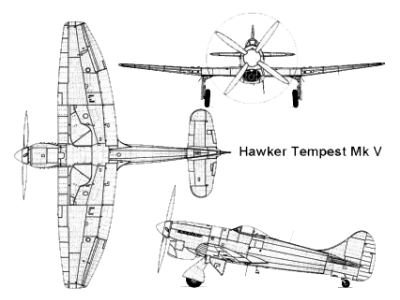 Hawker 'Tempest' 3 View
Hawker 'Tempest' 3 View
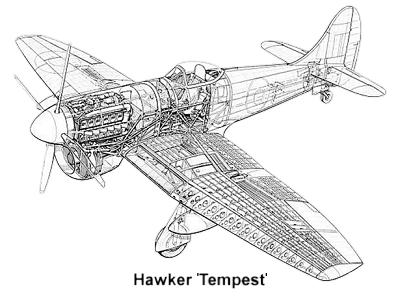 Hawker 'Tempest' Cutaway
Hawker 'Tempest' Cutaway
|
Specifications Tempest MkV:
Country of Origin: Great Britain
Crew: 1
Length: 33 ft 8 in (10.26 m)
Wingspan: 41 ft 0 in (12.49 m)
Height: 16 ft 1 in (4.90 m)
Weight: Empty: 9,250 lb (4,195 kg) Loaded: 11,400 lb (5,176 kg)
Powerplant: 1 × Napier Sabre IIA or IIB or IIC liquid-cooled H-24 sleeve-valve engine:,
2,180 hp (1,625 kW) Sabre IIA at + 9 lb/in² boost at 7,000 ft (2,133 m), 4,000 rpm
Performance
Maximum speed: 432 mph (695 km/h) Sabre IIA at 18,400 ft (5,608 m), Sabre IIB 435 mph at 19,000 ft (700 km/h at 5,791 m)
Range: 740 mi (1,190 km) 1,530 mi (2,462 km) with 90 gal (409 l) drop tanks
Service ceiling: 36,500 ft (11,125 m)
Rate of climb: 4,700 ft/min (23.9 m/s)
Armament
Guns:4 × 20 mm (.79 in) Mark II Hispano cannons, 200 rpg. Later models used Mark V Hispano Cannons.
Bombs: 2 × 500 lb (227 kg) or 1,000 lb (454 kg) bombs
|
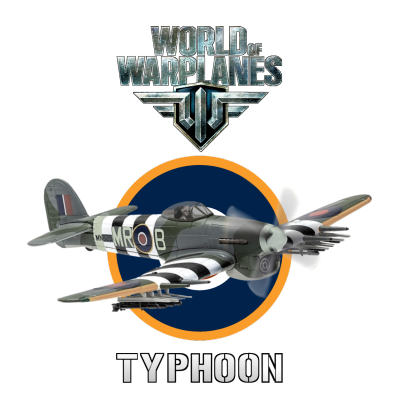
Into World of Warplanes? Check out MilMerchant at Redbubble
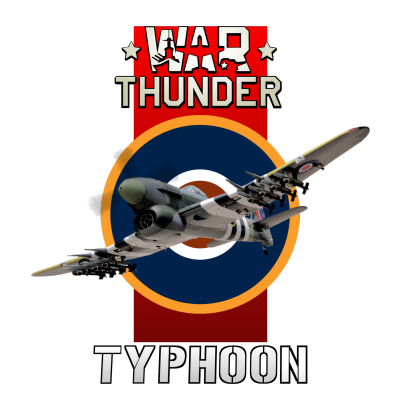
Into War Thunder? Check out MilMerchant at Spreadshirt
Back to Top
|
|
